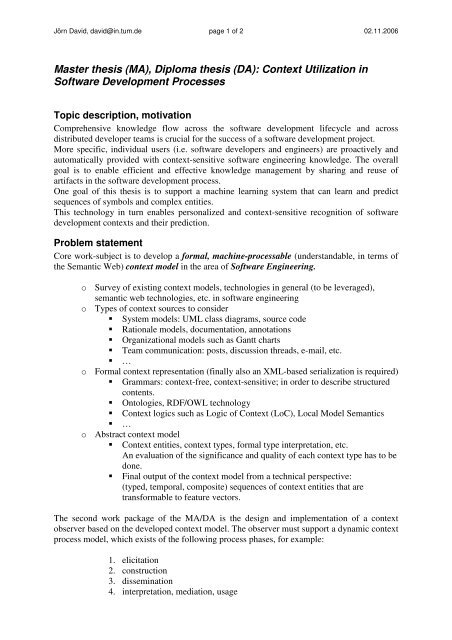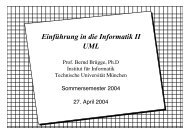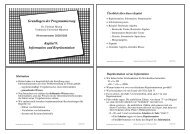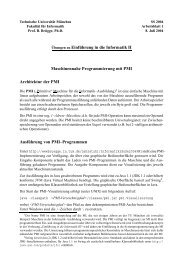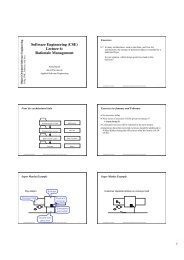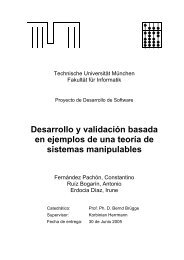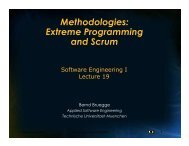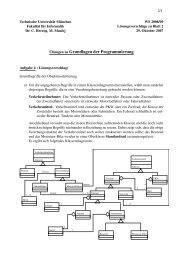Master thesis (MA), Diploma thesis (DA): Context Utilization in ...
Master thesis (MA), Diploma thesis (DA): Context Utilization in ...
Master thesis (MA), Diploma thesis (DA): Context Utilization in ...
Create successful ePaper yourself
Turn your PDF publications into a flip-book with our unique Google optimized e-Paper software.
Jörn David, david@<strong>in</strong>.tum.de page 1 of 2 02.11.2006<strong>Master</strong> <strong>thesis</strong> (<strong>MA</strong>), <strong>Diploma</strong> <strong>thesis</strong> (<strong>DA</strong>): <strong>Context</strong> <strong>Utilization</strong> <strong>in</strong>Software Development ProcessesTopic description, motivationComprehensive knowledge flow across the software development lifecycle and acrossdistributed developer teams is crucial for the success of a software development project.More specific, <strong>in</strong>dividual users (i.e. software developers and eng<strong>in</strong>eers) are proactively andautomatically provided with context-sensitive software eng<strong>in</strong>eer<strong>in</strong>g knowledge. The overallgoal is to enable efficient and effective knowledge management by shar<strong>in</strong>g and reuse ofartifacts <strong>in</strong> the software development process.One goal of this <strong>thesis</strong> is to support a mach<strong>in</strong>e learn<strong>in</strong>g system that can learn and predictsequences of symbols and complex entities.This technology <strong>in</strong> turn enables personalized and context-sensitive recognition of softwaredevelopment contexts and their prediction.Problem statementCore work-subject is to develop a formal, mach<strong>in</strong>e-processable (understandable, <strong>in</strong> terms ofthe Semantic Web) context model <strong>in</strong> the area of Software Eng<strong>in</strong>eer<strong>in</strong>g.o Survey of exist<strong>in</strong>g context models, technologies <strong>in</strong> general (to be leveraged),semantic web technologies, etc. <strong>in</strong> software eng<strong>in</strong>eer<strong>in</strong>go Types of context sources to consider System models: UML class diagrams, source code Rationale models, documentation, annotations Organizational models such as Gantt charts Team communication: posts, discussion threads, e-mail, etc. …o Formal context representation (f<strong>in</strong>ally also an XML-based serialization is required) Grammars: context-free, context-sensitive; <strong>in</strong> order to describe structuredcontents. Ontologies, RDF/OWL technology <strong>Context</strong> logics such as Logic of <strong>Context</strong> (LoC), Local Model Semantics …o Abstract context model <strong>Context</strong> entities, context types, formal type <strong>in</strong>terpretation, etc.An evaluation of the significance and quality of each context type has to bedone. F<strong>in</strong>al output of the context model from a technical perspective:(typed, temporal, composite) sequences of context entities that aretransformable to feature vectors.The second work package of the <strong>MA</strong>/<strong>DA</strong> is the design and implementation of a contextobserver based on the developed context model. The observer must support a dynamic contextprocess model, which exists of the follow<strong>in</strong>g process phases, for example:1. elicitation2. construction3. dissem<strong>in</strong>ation4. <strong>in</strong>terpretation, mediation, usage
Jörn David, david@<strong>in</strong>.tum.de page 2 of 2 02.11.2006On top of this a concrete use case (application doma<strong>in</strong>) is to be conducted that exploits thecontextualized <strong>in</strong>formation provided by the context observer.For further <strong>in</strong>formation please talk to Jörn David, david@<strong>in</strong>.tum.de.


